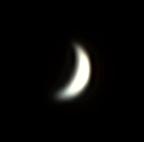D7200 Bug Nebula; Pluto with iPhone NightCap Pro (maybe)
Posted: 11 July 2015
Cloudy skies resumed on Thursday, 9 July. Had a brief monsoon thunderstorm late in the afternoon but only received 0.04" of rain. The sky was partly cloudy on Friday, 10 July.
|
Open: Friday, 10 July 2015, 1930 MST Temperature: 86°F |
Session: 847 Conditions: Partly cloudy, very breezy |
I first set up my old (1961) Edmund Scientific 3" Newtonian reflector telescope on the observatory patio:

My plan was to do some planet observing with the telescope.
1941 MST: observed Venus, 83X, with the Meade 8" LX200-ACF telescope in the observatory.
I then began using the 3" telescope. I viewed Venus at 40X and 60X. It was obvious that the telescope was badly out of collimation. I tried to re-collimate it but apparently the diagonal mirror position was misaligned. I will have to work on it during the daytime. I gave up using the 3" telescope this night.
2000 MST: returned to the 8" telescope and viewed Venus and Jupiter, 83X. About 30 minutes after sunset I noticed this monsoon storm buildup to the south:

I mounted the iPhone for afocal 77X imaging using the MX-1 Afocal Adapter. Seeing was not very good. Added a Variable Polarizing Filter adjusted to full darkness to keep Venus from overexposing. This is a stack of 1171 slo-mo (120 fps) Camera app video frames using full digital zoom:

This single frame photo (cropped), afocal 77X with some digital zoom, shows Jupiter and the four Galilean Moons:

Slewed to Saturn but seeing was not good at its location either. This is a stack of 1161 slo-mo video frames, afocal 154X, full digital zoom:

Unmounted the iPhone and viewed Saturn, 166X. The moons Dione, Rhea, Tethys, and Titan were visible. Tried using 354X in an attempt to view the moon Enceladus but it was not seen. (I have seen it previously in the 8" telescope, but not during this Saturn viewing season.)
2039 MST: clouds that were near the constellation of Scorpius were not a factor so decided to do a tour of some Deep Sky Objects in Scorpius using 83X. Viewed M80 (globular cluster; slow moving satellite was seen in the field-of-view), then M4 (globular cluster). Took a short break from DSO observing to take this iPhone 5s NightCap Pro photo of the western sky showing the planets Venus and Jupiter below the constellation of Leo:

Mouseover or tap on image for labels
Then resumed the DSOs in Scorpius tour. Viewed NGC6124 (open cluster), NGC6231 (open cluster), NGC6302 (Bug Nebula, planetary nebula), M6 (Butterfly Cluster), and M7 (open cluster). As I ended the tour clouds were beginning to interfer with the views. The sky was lighting up from distant lightning flashes.
2105 MST: slewed to Pluto (using the AutoStar), low in the southeast. I hoped to image Pluto once it rose higher if the clouds permitted.
2113 MST: decided to re-image NGC6302 (Bug Nebula) as the clouds were not a factor at its location. I had previously imaged it with the D7000 DSLR but thought I could do a better image with the D7200 DSLR. Mounted the D7200 at prime focus and did a focus test on Antares using a Bahtinov Mask. Then did several 30 second and 1 minute, unguided exposures using various ISO settings. This is a 1 minute, ISO 12800, exposure (cropped) of the Bug Nebula:

2136 MST: ended DSO imaging. Removed the camera. 2152 MST: clouds in the south, west, north, and east were holding off. 2207 MST: terminated a Kissing Bug. Only one was seen this night so I suspect the Kissing Bug season is finally ending.
Began setting up for the attempt to image Pluto using the iPhone 5s with NightCap Pro. SYNCed the AutoStar on the star Alpha Sagittarius, then slewed back to Pluto using the AutoStar. 2232 MST: clouds were approaching Pluto's position so decided I had better try imaging while I could. Powered on the GC Wi-Fi Adapter and used SkySafari Pro on the iPhone to GOTO Pluto. (SkySafari Pro planet positions are more accurate than the old AutoStar software.) This SkySafari Pro screen capture shows Pluto and stars at approximately the same scale as the image that follows it:

Mounted the iPhone 5s on the 8" telescope using the MX-1 adapter, afocal 77X. This NightCap Pro (Long Exposure, Light Boost, ISO 8000, 1/2sec) image is a 1 minute exposure taken at 2234 MST:

Mouseover or tap on image for label
By identifying stars in the SkySafari Pro screen capture and comparing them to the iPhone image I was able to make a tentative ID of Pluto (rollover or tap on the image to see my ID). I will have to take another image 24 hours later to confirm it (weather permitting).
2245 MST: the clouds were now a nuisance in much of the sky. Began closing up.
|
Close: Friday, 10 July 2015, 2305 MST Temperature: 76°F |
Session Length: 03h 35m Conditions: Fuzzy sky due to clouds |
Comments are welcome using Email. If you are on Twitter you can use the button below to tweet this report to your followers. Thanks.
Cassiopeia Observatory Home Page
Copyright ©2015 Michael L. Weasner / mweasner@me.com
URL = http://www.weasner.com/co/Reports/2015/07/11/index.html
